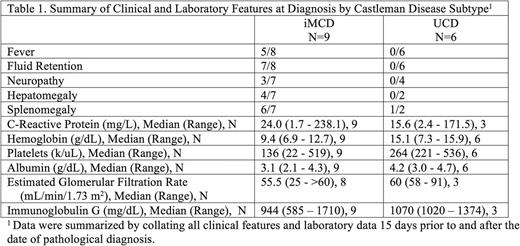Abstract
Introduction: Castleman disease (CD) describes a heterogeneous group of disorders that share characteristic histopathological lymph node features. Unicentric CD (UCD) involves localized lymphadenopathy whereas multicentric CD (MCD) involves generalized lymphadenopathy, cytokine-driven systemic inflammatory symptoms, and life-threatening multiple organ system dysfunction. Uncontrolled Human Herpesvirus 8 (HHV-8) infection causes approximately half of MCD cases (HHV-8-associated MCD). The etiology of HHV-8-negative MCD is unknown or idiopathic (iMCD). Currently, there is a lack of clinical and laboratory data describing the 3 subtypes of CD and their natural histories. Further, a systematic analysis of treatments for each subtype has not been performed. Acknowledging these gaps, the field prioritized the development of a natural history study of CD, ACCELERATE, which began enrollment in 2016. The primary objective of ACCELERATE is to collect real world data on the natural history and treatment of patients with CD.
Methods: ACCELERATE employs a unique two-armed approach to enroll individuals, who have had a lymph node pathology report suggesting "Castleman disease." The "physician-directed arm" (PDA) consists of 10 study sites located in 6 European countries, a traditional paper-based patient consent, and physician data entry via a web-based portal. In contrast, the "patient-powered arm" (PPA) involves a web-based platform through which participants located anywhere outside of Europe can enroll directly at www.CDCN.org/ACCELERATE. Once enrolled in the PPA, medical records, including pathology images, are obtained and data is extracted into the web-based portal by the ACCELERATE Registry Team (ART). Analyses of demographic, select clinical and laboratory, and treatment data were performed in cases with complete extracted records. A Certification & Access Subcommittee will review all cases to grade the quality of data that exist in favor of a CD diagnosis. iMCD diagnosis is based on recently-published consensus criteria.
Results: Since launching in August 2016, 51 subjects have consented, satisfied inclusion criteria, and completed all enrollment forms. The ART has completed extraction of medical records into the database for 15 patients, including 9 iMCD participants and 6 UCD participants. There were 4 females with iMCD and 3 with UCD. The median age at diagnosis was 31 (range: 14-58) for iMCD and 38.5 (range: 10-52) for UCD. Six iMCD patients demonstrated hyaline vascular or hypervascular histopathological features, 2 had mixed features, and 1 had plasmacytic features. All 6 UCD patients demonstrated hyaline vascular features. A greater number of clinical and laboratory abnormalities were observed in iMCD patients compared to UCD patients (Table 1). Four of the UCD patients received surgical excision as the sole therapy, and 2 were treated with surgical excision plus medical therapy with a corticosteroid or rituximab. Twenty-two different medications, including 4 different corticosteroids, were used to treat iMCD patients. Medications used simultaneously were classified as regimens. Twenty unique regimens were used, 7 of which included the anti-IL-6 monoclonal antibody, siltuximab, which is the only FDA-approved iMCD treatment. On average, each iMCD patient was treated with approximately 4.3 different regimens after diagnosis (mean time: 3.3 years). Regimens administered more than once to the iMCD cohort included: corticosteroid (CS) monotherapy (n=5), siltuximab+CS (n=5), rituximab monotherapy (n=4), tocilizumab+CS (n=4), siltuximab monotherapy (n=3), rituximab+CS (n=3), and rituximab+cyclophosphamide+CS (n=2).
Conclusions: The ACCELERATE Registry is a powerful tool for gathering international clinical and laboratory data for CD. It will allow investigators to describe the natural history of CD and provide a database for testing new hypotheses. Information gathered from the registry may lead to refinements in the diagnostic criteria and improved insights into disease management. Based on this preliminary analysis, it is evident that CD is a heterogeneous disease that is treated with a variety of therapeutic strategies. As sample size increases, we will gain critical insights into treatment effectiveness. We are actively seeking increased enrollment of participants around the world at www.CDCN.org/ACCELERATE.
Fajgenbaum: Janssen Pharmaceuticals: Research Funding. Liu: Evercore ISI: Employment. Lukac: PAREXEL International Czech Republic s.r.o, on behalf of Janssen Pharmaceuticals: Employment. Guilfoyle: Janssen: Employment, Equity Ownership. Tendler: Janssen Pharmaceuticals: Employment, Equity Ownership. Uldrick: National Institutes of Health: Patents & Royalties: immunomodulatory compound for KSHV malignancies (Inst); Merck: Research Funding; Celgene: Research Funding; Roche: Research Funding.
Author notes
Asterisk with author names denotes non-ASH members.


This feature is available to Subscribers Only
Sign In or Create an Account Close Modal